Recent Announcement on Dark Matter Research
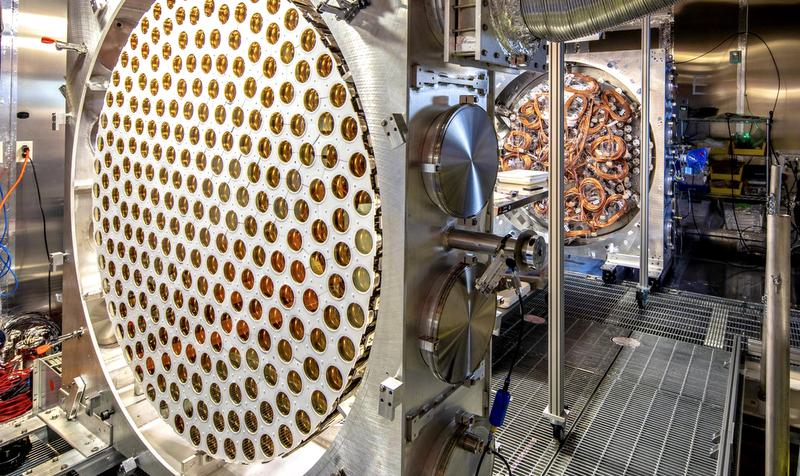
- 30 Sep 2024
In News:
Recently two representatives from the LUX-ZEPLIN (LZ) experiment, working 1.5 km underground at the Sanford Underground Research Facility in South Dakota, announced that they had placed the tightest restrictions yet on the identities of dark matter particles, resulting in a null finding that clarified which identities these particles could not have, leading to a sense of resignation rather than disappointment among the physics community, as similar experiments like XENON-nT in Italy and PandaX-4T in China have yielded empty results for decades despite significant efforts.
Background on Dark Matter
- Definition: Dark matter makes up most of the universe's mass, contributing to its structure.
- Composition: Likely consists of previously unknown particles that:
- Do not interact with photons.
- Remain stable over billions of years.
- Key Question: Can dark matter interact with atomic nuclei and electrons?
Experimental Strategies
- Proposed Method:
- Introduced by physicists Mark Goodman and Ed Witten in 1985.
- Concept: Use a “sail” (a chunk of metal) deep underground to detect dark matter interactions.
- Objective: Measure unknown mass and interaction rate (cross-section) of dark matter particles.
Scattering Cross-Section
- Concept:
- Similar to light interaction with different media (vacuum, glass, rock).
- Cross-sections indicate how readily a particle can scatter.
- Previous Limits: Proposed limits as small as 10−38cm210^{-38} text{cm}^210−38cm2.
- Current Achievements: Recent experiments have ruled out cross-sections as small as 10−44cm210^{-44} text{cm}^210−44cm2.
Challenges Ahead
- Neutrino Interference:
- As detectors increase in size, they also detect more noise from neutrinos, complicating dark matter detection.
- Both PandaX-4T and XENONnT report issues with neutrino signals.
- Resignation in Community:
- Scientists had hoped for clearer results before facing the challenge of distinguishing dark matter from neutrinos.
Alternative Research Avenues
- Focus on Lighter Particles:
- Exploring dark particles lighter than atomic nuclei for easier detection.
- Technological Development:
- Advancing technologies to measure minimal energy transfers using special materials.
Conclusion
- Ongoing Effort: The search for dark matter continues to unite scientific disciplines and require innovative approaches.
- Human Ingenuity: The pursuit reflects a broader effort to understand the universe, drawing on collective expertise and creativity.
NAMASTE programme
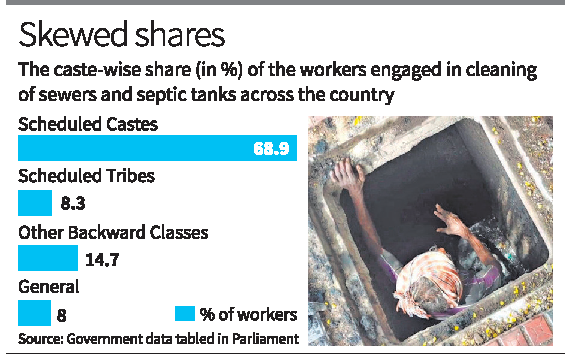
- 30 Sep 2024
In News:
A recent government survey has shed light on the demographics of workers engaged in the hazardous cleaning of urban sewers and septic tanks across India. This initiative, part of the Ministry of Social Justice and Empowerment's NAMASTE programme, highlights significant disparities within this labor sector.
Key Findings
- Community Representation: An overwhelming 91.9% of the 38,000 workers profiled belong to marginalized communities:
- Scheduled Castes (SC): 68.9%
- Other Backward Classes (OBC): 14.7%
- Scheduled Tribes (ST): 8.3%
- General Category: 8%
- Mortality Rates: Between 2019 and 2023, at least 377 individuals died while performing hazardous cleaning tasks, underscoring the dangers associated with this work.
The NAMASTE Programme
- Objective: The NAMASTE programme aims to mechanize sewer work to prevent fatalities linked to manual cleaning. It seeks to transition workers into safer, more sustainable roles as "sanipreneurs" by providing safety training, equipment, and capital subsidies.
- Background: This programme replaces the earlier Self-Employment Scheme for Rehabilitation of Manual Scavengers (SRMS), focusing on the more technical aspects of hazardous cleaning rather than manual scavenging.
- Namaste is a Central Sector Scheme of the Ministry of Social Justice and Empowerment (MoSJE) as a joint initiative of the MoSJE and the Ministry of Housing and Urban Affairs (MoHUA).
- The Scheme has been approved with an outlay of Rs. 360 crore for four years from 2022-23 to 2025-26.
- NAMASTE aims to achieve the following outcomes:
- Zero fatalities in sanitation work in India
- All sanitation work is performed by skilled workers
- No sanitation workers come in direct contact with human faecal matter
- Sanitation workers are collectivized into SHGs and are empowered to run sanitation enterprises
- All Sewer and Septic tank sanitation workers (SSWs) have access to alternative livelihoods
- Strengthened supervisory and monitoring systems at national, state and ULB levels to ensure enforcement and monitoring of safe sanitation work
- Increased awareness amongst sanitation services seekers (individuals and institutions) to seek services from registered and skilled sanitation workers
Progress and Coverage
- Implementation: Since the scheme's inception, 3,326 urban local bodies (ULBs) have begun profiling workers, with many reporting minimal or no workers engaged in hazardous cleaning.
- Data Collection: The government is gathering data from over 3,000 ULBs across 29 states and union territories to better understand the scope and risks associated with this labor.
AVGC: The Future of Media & Entertainment Industry
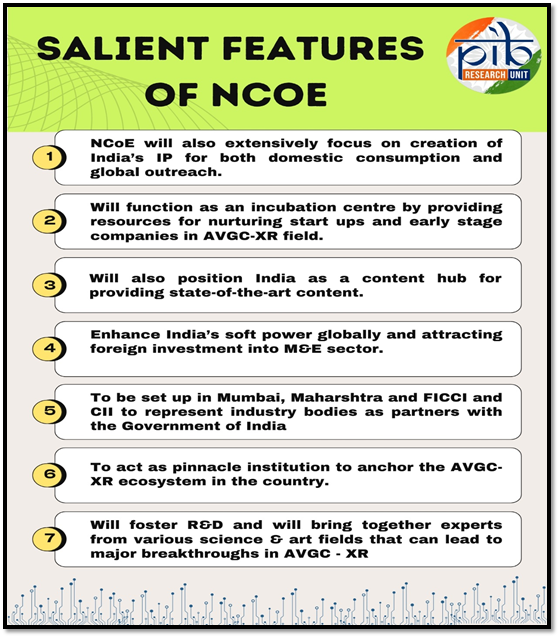
- 30 Sep 2024
Introduction
- The AVGC (Animation, Visual Effects, Gaming, Comics) sector is set to be the future of the media and entertainment industry.
- According to the FICCI-EY 2024 report, India now boasts the second-largest anime fan base globally and is projected to contribute 60% to the worldwide growth in anime interest in the coming years.
- In a significant step toward making India a global hub for AVGC, the Union Cabinet recently approved the establishment of a National Centre of Excellence (NCoE) for Animation, Visual Effects, Gaming, Comics, and Extended Reality (AVGC-XR) in Mumbai.
NCoE Background
- NCoE will be set up as a Section 8 Company under the Companies Act, 2013 in India with Federation of Indian Chambers of Commerce & Industry and Confederation of Indian Industry representing the industry bodies as partners with the Government of India.
- The establishment of the NCoE follows the Union Minister of Finance and Corporate Affairs 2022-23 budget announcement, which proposed the creation of an AVGC task force in the country.
- NCoE AVGC aims at creating a world class talent pool in India to cater to the Indian as well as global entertainment industry.
- Provisionally named the Indian Institute for Immersive Creators (IIIC), this center aims to revolutionize the AVGC sector and foster innovation in immersive technologies.
- It will be modeled after renowned institutions like the Indian Institutes of Technology (IITs) and Indian Institutes of Management (IIMs).
Objective of NCoE (IIIC)
Boasting a growth rate of 25% and an estimated value of ?46 billion by 2023 (FICCI-EY Report 2023), the animation industry in India is thriving and offers a promising future for passionate young talent.
Below are some of the key objectives of the NCoE (IIIC):
- Focusing of creating Indian IP
- Leveraging our cultural heritage in new age
- Create a multiplier effect in the industry
- An industry led initiative, in partnership with state and academia
- Integrated focus on education, skilling industry, development, innovation
- Hub and spoke model of development to be followed
- IIIC as the hub and several center’s as its spokes dedicated innovation and research fund to promote start-up ecosystem
Conclusion
The Union Cabinet's approval of the National Centre of Excellence (NCoE) for AVGC marks a pivotal step in strengthening India’s media and entertainment industry. This initiative is set to boost the economy while creating new job opportunities in the rapidly growing AVGC sector. As a global hub for filmmaking, India's advancements in technology and infrastructure will enable the production of high-quality content, positioning the country as a leader in technological innovation and creativity.
MARBURG VIRUS OUTBREAK IN RWANDA
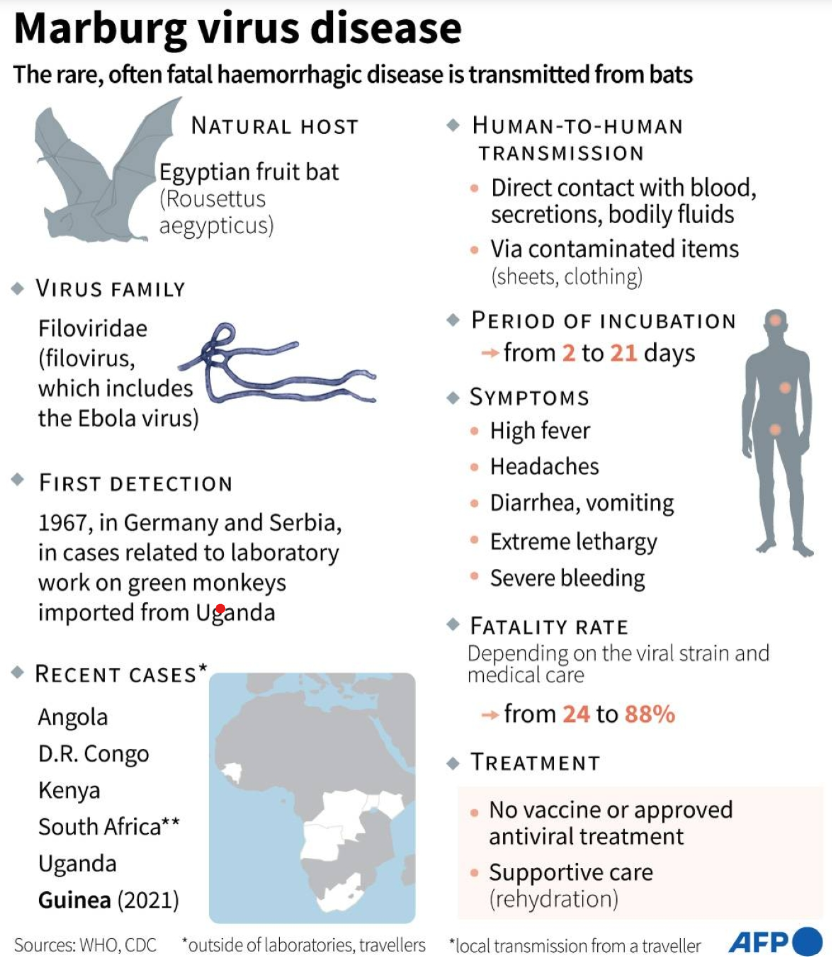
- 30 Sep 2024
In News:
Rwanda is currently facing an outbreak of Marburg virus disease (MVD), leading to six fatalities, primarily among healthcare workers.
What is Marburg Virus Disease?
Marburg virus disease is a severe and often fatal illness first identified in 1967 in Germany. It is caused by the Marburg virus, which is primarily transmitted to humans through contact with infected animals, particularly fruit bats.
Current Situation in Rwanda
The ongoing outbreak has claimed six lives, most of whom were healthcare professionals. The Minister of Health has emphasized the need for heightened preventive measures and community vigilance.
Symptoms and Transmission
Common symptoms of MVD include high fever, severe headache, watery diarrhea, abdominal pain, and vomiting. The virus spreads through direct contact with the blood, secretions, and bodily fluids of infected individuals.
Available Treatments and Supportive Care
There is currently no specific treatment for Marburg virus disease. Supportive care, including symptom management and hydration, is critical, and early medical attention is essential for those exhibiting symptoms.
Preventive Measures and Recommendations
To prevent the spread of MVD, individuals should:
- Practice good hygiene.
- Avoid contact with infected persons.
- Ensure thorough cooking of animal products.
- Use protective equipment when caring for sick patients.
Global Context and Pandemic Risk
While Marburg virus disease poses a significant mortality risk and can spread between humans, its pandemic potential is lower than that of more contagious viruses. Rapid containment efforts are essential to prevent wider outbreaks.
INDIA DESERVES PERMANENT UNSC SEAT: BHUTAN
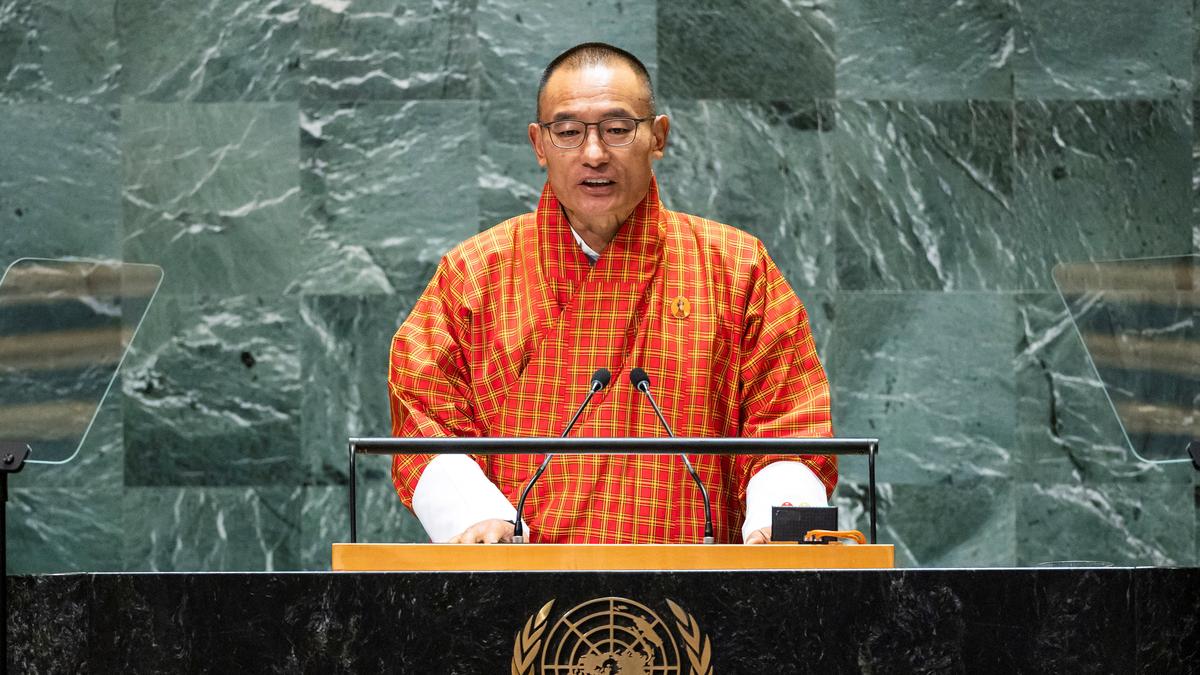
- 30 Sep 2024
In News:
With its significant economic growth and leadership of the Global South, India deserves a permanent seat at the UN Security Council, says Bhutan’s Prime Minister Tshering Tobgay.
Key Highlights:
- Economic Growth: Highlights India’s significant economic growth and its leadership in the Global South as justifications for this status.
- International Backing: India’s bid gains momentum with support from several UN Member States, including France, the UK, and the U.S.
- Need for Reform: Bhutan emphasized that the UNSC is outdated and must evolve to reflect contemporary geopolitical and economic realities.
- Advocacy for Representation: Bhutan has long called for a more representative and effective Security Council, backing India’s inclusion at the high table.
About UN Security Council (UNSC)
- Composition: Total of 15 member states.
- 5 permanent members (P5): China, France, Russia, the United Kingdom, and the United States (with veto rights).
- 10 non-permanent members elected for two-year terms.
- Election of Non-Permanent Members:
- Elected on a regional basis:
- 5 seats for African and Asian states.
- 2 seats for Latin American and Caribbean states.
- 1 seat for Eastern European states.
- 2 seats for Western European and other states.
- Elected on a regional basis:
- Presidency:
- Rotates monthly among members, following the English alphabetical order of country names.
- Primary Functions:
- Maintain international peace and security.
- Investigate and resolve disputes.
- Impose sanctions and authorize the use of force.
- Establish peacekeeping missions.
- Make recommendations to member states.
- Meeting Schedule:
- Regular meetings at UN headquarters in New York.
- Can convene at any time in response to emergencies.
- Decision-Making:
- Requires affirmative votes from at least 9 of the 15 members.
- Any of the P5 can veto resolutions, raising concerns about the Council's effectiveness.
- Subsidiary Bodies:
- Includes committees, working groups, and sanctions committees focused on specific issues like counter-terrorism, nuclear non-proliferation, and peacekeeping operations.
- Reforming the UN Security Council (UNSC)
- Charter Amendments:
- Reforming the UNSC requires amendments to the UN Charter.
- Voting Requirements:
- An amendment must be adopted by a two-thirds majority of the General Assembly.
- It must also be ratified by two-thirds of UN member states, including all permanent members of the UNSC.
- Charter Amendments:
